NCERT Exemplar Solutions for Class 11 Biology Chapter 15 Plant Growth and Development
These Solutions are part of NCERT Exemplar Solutions for Class 11 Biology. Here we have given NCERT Exemplar Solutions for Class 11 Biology Chapter 15 Plant Growth and Development.
VERY SHORT ANSWER QUESTIONS
Question 1.
Fill the places with appropriate word/words.
(a) A phase of growth which is maximum and fastest is ………
(b) Apical dominance as expressed in dicotyledonous plants is due to the presence of more ……. in the apical bud than in the lateral ones.
(c) In addition to auxin, a ……. must be supplied to culture medium obtain a good callus in plant tissue culture.
(d)…….. of a vegetative plants are the sites of photoperiodic perception.
Solution:
(a) A phase of growth which is maximum and latest is exponential phase.
(b) Apical dominance as expressed in dicotyledonous plants is due to the presence or more auxins in the apical bud than in the lateral ones.
(c) In addition to auxin, a cytokinin must be g supplied to culture medium to obtain a good callus in plant tissue culture.
(d) Leaves of vegetative plants are the sites of photoperiodic perception.
Question 2.
Plant Growth Substances (PGS) have innumerable practical applications. Name the PGS you should use to
(a) increase yield of sugarcane
(b) promote lateral shoot growth
(c) cause sprouting of potato tuber
(d) inhibit seed germination
Solution:
(a) Spraying gibberellins
(b) Application of auxins
(c) Ethylene
(d) ABA
Question 3.
A primary root grows from 5 cm to 19 cm in a week. Calculate the growth rate and relative growth rate over the period.
Solution:
Growth depends upon three factors – initial size (WQ), rate of growth (r) and time interval (+) for which the rate of growth is retained.
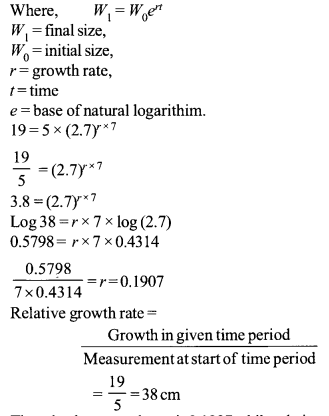
Thus absolute growth rate is 0.1907 while relative growth rate is 3.8 cm.
Question 4.
Gibberellins were first discovered in Japan when rice plants were suffering from bakane (the foolish seedling disease) caused by a fungus Gibberella fujikuroi.
(a) Give two functions of this phytohormone.
(b) Which property of gibberellin caused foolish seedling disease in rice?
Solution:
Following are the two functions of gibberellin:
(i) It produces the phenomenon of bolting i. e., the growth of the intemodal region of stem in rosette plants.
(ii) It induces seed germination and break bud and seed domancy.
(b) The rice seeding/plant show excessive growth in their intemodal region when gets infected by fungus Gibberellafujikuroi. This fungus produces excessive amount of plant hormone GA that makes plants taller in comparison to the normal plant foolishly and many results into death of the plant.
Question 5.
Classify the following plants into Long Day Plants (LDP), Short Day plants (SDP) and Day Neutral Plants (DNP) Xanthium, henbane (Hyoscyamus niger), spinach, rich, strawberry, Bryophyllum, sunflower, tomato, maize.
Solution:
Long Day Plant (LDP) The plants that requires the exposure light for a longer period exceeding a well defined critical duration of light are long day plants.
Among the above given plant LDP are for henbane, Bryophyllum and spinach. Short Day Plants (SDP) The Plants that requires light for a period less than well defined critical duration of light, e.g., Xanthium, rice, strawberry.
Day Natural Plants (DNP) The exposure to light does not affect the flowering in certain plants, e.g, DNP, sunflower, tomato, maize.
Question 6.
A farmer grows cucumber plants in his field. He wants to increase the number of female flowers in them. Which plant growth regulator can be applied to achieve this?
Solution:
Ethylene, is a plant growth regulator that has feminizing effect on sex expression. Ethylene promotes formation of female flowers in monoecious plants like cucumber.
Question 7.
Where are the following hormones synthesised in plants?
(a) IAA
(b) Gibberellins
(c) Cytokinins
Solution:
(a) IAA i.e., Indole acetic acid. It is synthesised at the growing apices of the plant, e.g., shoot tip, leaf primordia and developing seeds.
(b) Gibberellins It is synthesised in the apical shoot buds, young leaves, root tips and developing seeds.
(c) Cytokinins are synthesised mainly in routs, but synthes also occurs in the endosperm of seeds, growing embryo etc.
Question 8.
Growth is one of the charactristic of all living organism? Do unicellular organism also grow? If so, what are the parameters?
Solution:
1. Lag phase- In this phase growth is slow.
2. Exponential phase- It shows rapid growth and maintains maximum growth for sometime.
3. Stationary phase- In this phase Growth diminishes and ultimately stops.
Question 9.
In the figure of sigmoid growth curve given below, label segments 1,2 and 3.
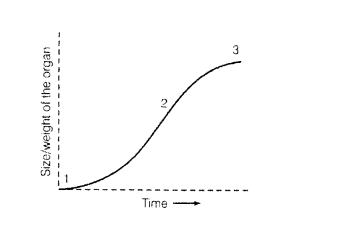
Solution:
Growth is the main characteristic that distinguish living organisms from non-living. All living organism grow in number and then accumulate biomass and grow in size as well.
Increase in number of cells as well as increase in size and length of each cell, exhibits growth of all living organism.
In unicellular organism, the growth is synchronized with reproduction.
These organism when divide they produce offspring (reproduction) i.g., each cell accumulate (synthesise) protoplasm and increase in size but at a certain a limit and divide to from two cells.
Question 10.
The rice seedlings infected with fungus Gibberellafujikuroi is called foolish seedlings? What was the reason behind it?
Solution:
The rice seedling infected with fungus Gibberella fujikuroi are called foolish seedling because infected plants grow excessively taller than rest of the non infected rice plants in the field fall over and be unharvestable.
SHORT ANSWER QUESTIONS
Question 1.
Nicotiana tobacum, a short day plant, when exposed to more than critical period of light fails to flower. Explain.
Solution:
Short day plants are those plants that flower only when the exposure to duration of light is below critical period. Tobacco, being a short day plant is unable to show flowering when it is exposed to light above than the critical period.
Question 2.
Explain in 2-3 lines each of the following terms with the help of examples taken from different plant tissues.
(a) Differentiation
(b) De-differentiation
(c) Re-differentiation
Solution:
(a) Differentiation is permanent in composition
structure size and function of cells, tissue or organs. For example the meristematic tissues in plants gives rise to new cells which then mature and get differentiated into tissue or an organ of the plant, e.g., cells, distal to root apical meristem form root cap, cell of the periphery form epiblema, followed by cortex, etc.
(b) De-differentiation is the process of regain of differentiated cells so that they again become differentiated and able to divide, e.g., in dicot stem, the cortical cells get de-differentiate and become meristematic to form cambium (interfascicular cambium, and fascicular cambiums).
(c) Re-differentiation The cambium cells thus formed, again re-differentiate to form secondary cortex cells, secondary xylem and phloem elements and phelloderm in case of secondary growth of woody dicot plants.
Question 3.
The role of ethylene and abscissic acid is both positive and negative. Justify the statement.
Solution:
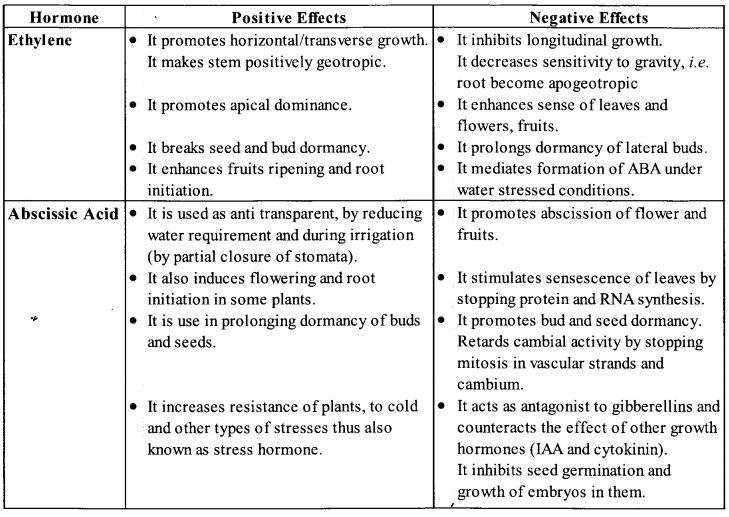
Question 4.
In animals, there are special glands secreting
hormones, whereas there are no glands in plants. Where are plant hormones formed? How are the hormones translocated to the site of activity?
Solution:
The plant hormones are synthesised by the plant cells needed. Few hormones are specifically synthesised at a particular part of the plant like auxin synthesised in growing shoot apices and ethylene is secretes by ripened fruits.
Cytokinin is found in dividing cells. Unlike plants animal 1 being more advanced, and organised they have proper hormone secreting glands and organs.
These are transported through the transport system of their body in both plant and animals. In plants, hormone are translocated via xylem and phloem to the site of activity.
Question 5.
In a slide showing different types of cells can you identify which type of the cell may be meristematic and the one which is incapable of dividing and how?
Solution:
On the basis of the following characteristics the meristemtic cells can be identified.
(i) Cell consist thin cellulose wall and dense cytoplasm with large nucleus.
(ii) Among meristematic cells, plasmodesmal connections are more numerous.
(iii) Cell division, i. e., mitosis arid its various stages are distinctly visible.
(iv) Chromosomes of cells replicate and divide into two homologous chromatids.
All these features contribute to open ended growth where structure is in complete in meristematic regions.
Whereas, cells incapable of dividing show features such as
(i) Attains particular shape, size and thickening.
(ii) Undergoes structural and physiological differentiation.
(iii) Different types of cell are formed such as epidermis, cortex, vascular tissues.
Question 6.
A rubber band stretches and reverts back to its original position. Bubble gum stretches, but it would not return to its original position.
Is there any difference between the two processes? Discuss it with respect to plant growth (hint elasticity (reversible) plasticity (irreversible).
Solution:
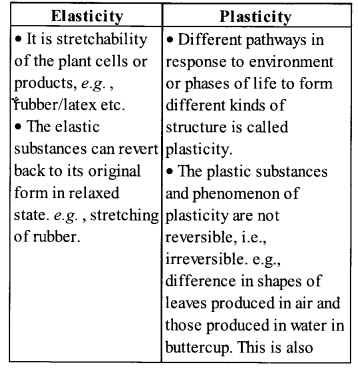
Question 7.
Label the diagram.
A. This is which part of a dicotyledonous plants?
B. If we remove part 1 from the plant, what will happen?
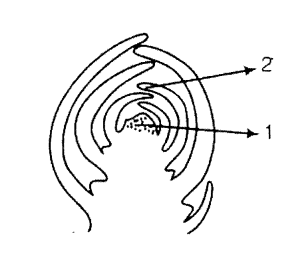
Solution:
Representation the labelling of the given diagram is as follows
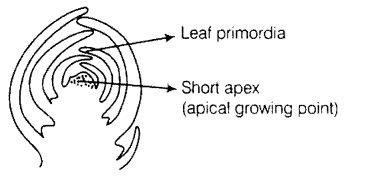
A. the plant part in the given diagram is growing shoot apex.
B. Removal of shoot apex will help to overcome the apical dominance. Thus, the lateral buds grow faster, giving rise to branches and give the plant a bushy appearance.
Question 8.
Both animals and plants grow. Why do we say that growth and differentiation in plants is open and not so in animals? Does this statement hold true for sponges also?
Solution:
- Growth in plant is totally different from the animal growth as growth in plant is unlimited and indefinite.
- Root and shoot in tips in the plants are open ended i.e. they always grow and form new organ to replace the older and senescent one due to presence of meristem cells, which are capable to grow and divide.
- Thus, the plant growth continues throughout the life. On the contrary, animal growth is limited as growth /stops as soon as they mature. Sponges are those animals which show cellular level of organisation.
- These animals posses totipotent cells which are capable of giving rise to all other cells in sponges.
- A small part detached from a sponge can regenerate into a whole new sponge.
- However growth in sponges cannot be called open or indefinite as they cannot grow beyond a certain size.
Practically, they do not show open ended growth.
Question 9.
Define parthenocarpy. Name the plant hormone used to induce parthenocarpy.
Solution:
Parthenocarpy is the process where fruit develop without fertilisation and so, it lacks contain seed. Seedless fruits are developed in some plants. Certain phytohormone induce development of fruit without fertilisation. This can also be induced artificially by spraying auxin an*i gibberellins in certain plants like, grapes, papaya, etc. ,
Question 10.
While eating watermelons, all of us wish it was seedless. As a plant physiologist can you suggest any method by which this can be achieve.
Solution:
The seedless, fruits can be produced by the process of parthenocarpy. In this fruits are
developed without fertilisation, so, seeds are not formed in the fruit. Artifically parthenocarpy can be induced by spraying auxin and gibberellin to produce seedless watermelons.
Question 11.
On germination a seed first produces shots with leaves, flowers appear later,
A. Why do you think this happens?
B. How is this advantageous to the plant?
Solution:
A. With the germination of seeds the plant
enters into vegetative growth period. This period tabes light stimulus i. e., photoperiod) and synthesise the florigen (a flowering hormone) that flowering.
B. The vegetative growth period prepares the plant to bear reproductive structure like flower, fruits and seeds, and allows it to grow, mature and reproduce.
Question 12.
Fill in the blanks
A. Maximum growth is observed in …… phase.
B. Apical dominance isdue to ………. .
C. …… initiate rooting.
D. pigment involved in phote photoperception in fiowering plants in ……….
Solution:
A. Exponential
B. Auxin
C. Cytokinin
D. Phytochrome.
LONG ANSWER QUESTIONS
Question 1.
Some varieties of wheat are known as spring wheat while others are called winter wheat. Former variety is sown and planted in spring and is harvested by the end of the same season. However, winter varieties, if planted in spring, fail to flower or produce mature grains within a span of a flowering season. Explain, why?
Solution:
- Some annual plants such as wheat do not flower, unless they experience a low temperature during spring they remain vegetative but after receiving low temperature (in winter) they grow further to bear flowers and fruits.
- During winter the low temperature prevents precocious reproductive development in autumn, thus enabling the plant to reach vegetative maturity before reproductive phase.
- Thus, in spring when spring varieties are planted they flower and bear fruits prior to end of growing season.
- But, if the winter varieties are planted in spring, they fail to flower and produce mature grains before the end of growing season, as they could not perceive low temperature of winters.
Question 2.
Name a hormone which
A. is gaseous in nature
B. Is responsible for phototropism
C. induces femaleness in flowers of cucumber
D. is used for killing weeds (dicots)
E . induces flowering in long day plants.
Solution:
A. Ethylene is a hormone which is gaseous in nature.
B. Auxin (synthetic auxin 2-4D) is responsible for phototropism.
C. Ethylene induces ferminising effect. External supply of very small quantity of ethylene can increase the number of female flowers and hence fruits as in cucumber.
D. Synthetic auxin (2-4D) that kills broad leaved dicot weeds and is used as weedicides.
E. Gibberellins induces flowering in long-day plants.
We hope the NCERT Exemplar Solutions for Class 11 Biology at Work Chapter 15 Plant Growth and Development, help you. If you have any query regarding NCERT Exemplar Solutions for Class 11 Biology at Work Chapter 15 Plant Growth and Development, drop a comment below and we will get back to you at the earliest.